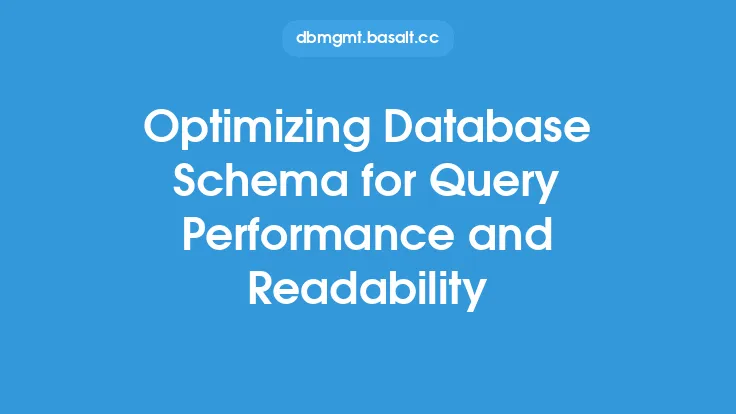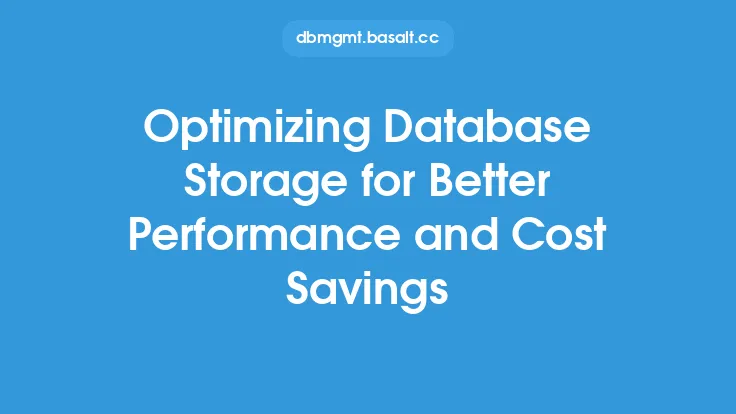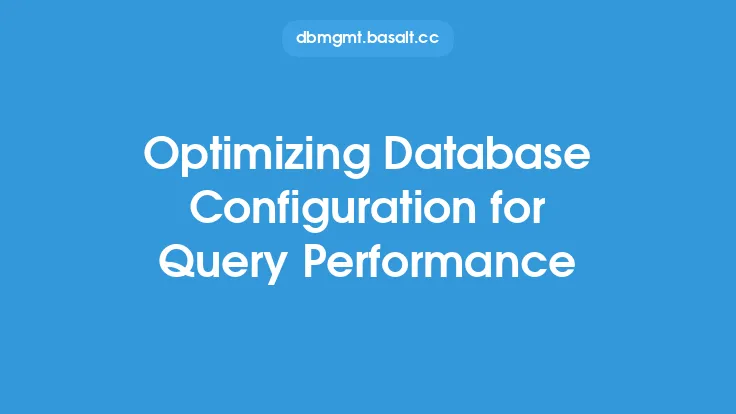When it comes to database administration, one of the most critical aspects is ensuring that the database performs optimally. A well-performing database is essential for any application or system that relies on it, as it directly impacts the user experience, scalability, and overall efficiency of the system. Database performance standards are a set of guidelines and best practices that help database administrators optimize their databases for speed and efficiency. In this article, we will delve into the world of database performance standards, exploring the key factors that affect database performance, and discussing the various techniques and strategies for optimizing database performance.
Introduction to Database Performance
Database performance refers to the ability of a database to process and respond to queries, transactions, and other operations in a timely and efficient manner. It is a critical aspect of database administration, as poor performance can lead to slow response times, errors, and even crashes. Database performance is affected by a variety of factors, including hardware, software, database design, and usage patterns. To optimize database performance, database administrators must consider these factors and implement strategies that minimize bottlenecks, reduce latency, and maximize throughput.
Key Factors Affecting Database Performance
Several key factors affect database performance, including:
- Hardware: The type and quality of hardware used to host the database, such as CPU, memory, storage, and networking equipment, can significantly impact performance.
- Software: The database management system (DBMS) and other software components, such as operating systems and applications, can also affect performance.
- Database design: The design of the database, including the schema, indexing, and normalization, can impact performance.
- Usage patterns: The type and volume of queries, transactions, and other operations can affect performance.
- Data volume: The amount of data stored in the database can impact performance, particularly if the database is not designed to handle large volumes of data.
Database Performance Metrics
To measure and optimize database performance, database administrators use a variety of metrics, including:
- Response time: The time it takes for the database to respond to a query or transaction.
- Throughput: The number of queries or transactions that the database can process per unit of time.
- Latency: The delay between the time a query or transaction is submitted and the time it is processed.
- CPU utilization: The percentage of CPU resources used by the database.
- Memory utilization: The percentage of memory resources used by the database.
- Disk utilization: The percentage of disk resources used by the database.
- Network utilization: The percentage of network resources used by the database.
Optimizing Database Performance
To optimize database performance, database administrators can use a variety of techniques and strategies, including:
- Indexing: Creating indexes on columns used in WHERE, JOIN, and ORDER BY clauses can improve query performance.
- Normalization: Normalizing the database design can improve data integrity and reduce data redundancy.
- Denormalization: Denormalizing the database design can improve query performance by reducing the number of joins required.
- Caching: Implementing caching mechanisms, such as query caching or result caching, can improve performance by reducing the number of queries executed.
- Partitioning: Partitioning large tables can improve query performance by reducing the amount of data that needs to be scanned.
- Parallel processing: Implementing parallel processing techniques, such as parallel query execution or parallel indexing, can improve performance by utilizing multiple CPU cores.
Query Optimization
Query optimization is a critical aspect of database performance optimization. Database administrators can use a variety of techniques to optimize queries, including:
- Query analysis: Analyzing query execution plans to identify bottlenecks and optimization opportunities.
- Indexing: Creating indexes on columns used in WHERE, JOIN, and ORDER BY clauses can improve query performance.
- Rewriting queries: Rewriting queries to use more efficient syntax or to reduce the number of joins required.
- Using query hints: Using query hints to guide the query optimizer in choosing the most efficient execution plan.
Database Configuration
Database configuration is also critical to database performance. Database administrators can optimize database configuration by:
- Adjusting database parameters: Adjusting database parameters, such as buffer pool size or sort area size, can improve performance.
- Configuring disk storage: Configuring disk storage to optimize disk I/O performance, such as using RAID or SSD storage.
- Configuring networking: Configuring networking to optimize network I/O performance, such as using high-speed networking equipment.
Monitoring and Troubleshooting
Monitoring and troubleshooting are essential to maintaining optimal database performance. Database administrators can use a variety of tools and techniques to monitor database performance, including:
- Performance monitoring tools: Using performance monitoring tools, such as Oracle Enterprise Manager or SQL Server Management Studio, to monitor database performance metrics.
- Log analysis: Analyzing database logs to identify performance issues and optimization opportunities.
- Troubleshooting: Using troubleshooting techniques, such as query analysis or system monitoring, to identify and resolve performance issues.
Best Practices
To ensure optimal database performance, database administrators should follow best practices, including:
- Regularly monitoring database performance: Regularly monitoring database performance to identify issues and optimization opportunities.
- Implementing indexing and caching: Implementing indexing and caching mechanisms to improve query performance.
- Optimizing database configuration: Optimizing database configuration to improve performance.
- Using query optimization techniques: Using query optimization techniques, such as query analysis and rewriting, to improve query performance.
- Testing and validating: Testing and validating database performance to ensure that changes do not introduce new issues.
Conclusion
In conclusion, database performance standards are a critical aspect of database administration, and optimizing database performance is essential for ensuring the scalability, efficiency, and reliability of database-driven applications. By understanding the key factors that affect database performance, using performance metrics to measure and optimize performance, and implementing techniques and strategies for optimizing database performance, database administrators can ensure that their databases perform optimally. Additionally, following best practices, such as regularly monitoring database performance, implementing indexing and caching, and using query optimization techniques, can help database administrators maintain optimal database performance over time.





